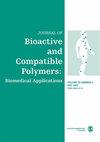多孔多糖支架:伤口愈合和干细胞分化的概念验证研究
IF 2.1
4区 生物学
Q3 BIOTECHNOLOGY & APPLIED MICROBIOLOGY
引用次数: 0
摘要
将理想的聚合物特性和合成方法结合起来,利用不同结构的材料,可以用于不同的临床应用,如伤口愈合和干细胞分化。天然聚合物,特别是多糖,具有生物相容性,据报道与细胞外基质成分具有结构相似性。本研究利用罗望子仁中分离的半乳糖葡聚糖制备多孔支架,并研究其在干细胞附着和伤口愈合中的应用。人间充质干细胞(hMSCs)生长呈圆形形态,增殖增强。在临床前小鼠模型中,用纳米银对支架进行表面功能化,以提高其抗菌活性和伤口愈合潜力。目前的研究提供了干细胞如何附着和生长在具有抗菌、生物相容性和可生物降解特性的天然低成本多糖支架中的见解。本文章由计算机程序翻译,如有差异,请以英文原文为准。
Porous polysaccharide scaffolds: Proof of concept study on wound healing and stem cell differentiation
The combination of desirable polymer properties and methods for synthesis, utilizing materials with various architectures, could be adopted for diverse clinical applications such as wound healing as well as stem cell differentiation. Natural polymers, particularly polysaccharides, are biocompatible and are reported to have structural similarities with extracellular matrix components. In this scenario, the present study fabricated a porous scaffold using a polysaccharide, galactoxyloglucan, isolated from Tamarind seed kernel, and studied its applications in stem cell attachment and wound healing. In-growth of human mesenchymal stem cells (hMSCs) presented a rounded morphology with increased proliferation. Scaffolds were surface-functionalized with silver nanoparticles to increase the antibacterial activity and the wound healing potential evaluated in preclinical mouse models. The current study provides an insight into how stem cells attach and grow in a naturally derived low-cost polysaccharide scaffold with antibacterial, biocompatible, and biodegradable properties.
求助全文
通过发布文献求助,成功后即可免费获取论文全文。
去求助
来源期刊

Journal of Bioactive and Compatible Polymers
工程技术-材料科学:生物材料
CiteScore
3.50
自引率
0.00%
发文量
27
审稿时长
2 months
期刊介绍:
The use and importance of biomedical polymers, especially in pharmacology, is growing rapidly. The Journal of Bioactive and Compatible Polymers is a fully peer-reviewed scholarly journal that provides biomedical polymer scientists and researchers with new information on important advances in this field. Examples of specific areas of interest to the journal include: polymeric drugs and drug design; polymeric functionalization and structures related to biological activity or compatibility; natural polymer modification to achieve specific biological activity or compatibility; enzyme modelling by polymers; membranes for biological use; liposome stabilization and cell modeling. This journal is a member of the Committee on Publication Ethics (COPE).
 求助内容:
求助内容: 应助结果提醒方式:
应助结果提醒方式:


